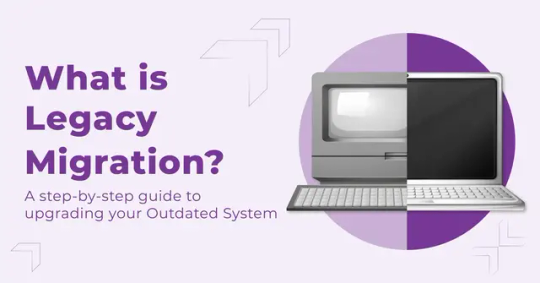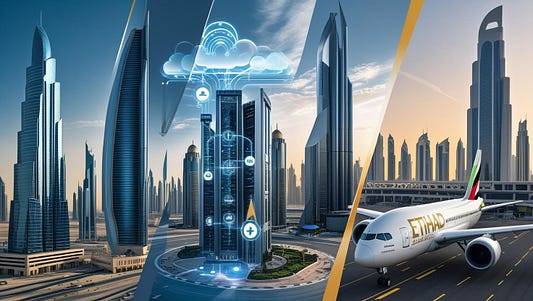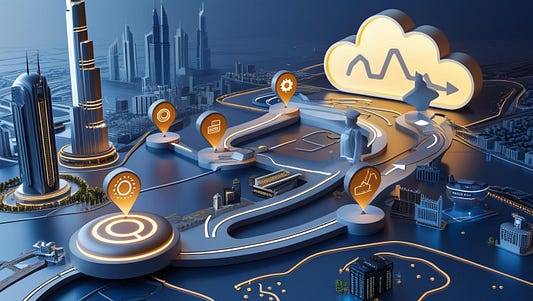#Legacy Migration
Explore tagged Tumblr posts
Link
Learn how to ensure regulatory compliance in the age of legacy software. Know the importance of hiring a legacy software modernization company in maintaining security and efficiency.
0 notes
Text
Guide To Legacy System Migration
This content covers the concept of legacy migration—the process of updating outdated systems without the need for complete replacements.

It emphasizes the importance of upgrading technology to keep up with advancements without incurring the high costs and disruptions of implementing entirely new systems.
Key Highlights:
1)Understanding Legacy Systems: Legacy systems are outdated software, hardware, or systems still in use, often unsupported by original vendors. These systems can create issues due to lack of support, high maintenance costs, and compatibility issues with new technologies.
2) Challenges with Legacy Systems :Legacy systems pose security and compliance risks, maintenance costs, and performance issues. However, many organizations retain them due to high replacement costs, integration challenges, and user familiarity.
3) Why Legacy Migration Is Crucial:
Improved Security: Newer systems offer enhanced security features.
Regulatory Compliance: Migration helps meet regulatory standards (e.g., GDPR).
Operational Efficiency: Modern systems are more efficient.
Support for Innovation: Upgrading can free up resources for new technology.
4) Best Practices for Legacy Migration:
Assess the Current System: Evaluate system requirements, data volume, and security needs.
Choose a Migration Strategy: Options include:
Lift-and-shift: Moving the system as-is.
Refactoring: Modifying the system for better compatibility.
Plan the Migration: Develop a timeline, allocate resources, and test migration steps.
Data Migration and Testing: Transfer data and test the new system for functionality, security, and performance.
Deployment and Monitoring: Launch the new system and continually monitor its performance.
Conclusion:
Legacy migration is cost-effective and improves security, compliance, and efficiency. Covrize’s experienced team can help organizations plan and execute migrations, customizing solutions to meet specific business needs.
By following these best practices, organizations can transition smoothly, reduce risks, and set a foundation for future growth and innovation.
Expertise in digital transformation and legacy migration can be invaluable in supporting a successful transition.
0 notes
Text
Enhancing AI Services with Computer Vision: Transforming Perception into Intelligence
Experience the transformative potential of computer vision in artificial intelligence. Witness how this advanced technology empowers solutions to extract, comprehend, and respond to data from images, videos, and visual inputs. By harnessing cutting-edge machine learning and artificial intelligence, computer vision becomes the digital equivalent of human vision, revolutionizing industries. Explore the seamless integration of AI and computer vision, revolutionizing how we interpret the visual world.
#computer vision in artificial intelligence#legacy systems#legacy migration#travel management company#online travel agency#Customer Data Platform#Conversational AI#AI chatbot
1 note
·
View note
Text
🎨 The Hidden Archive – eine Ausstellung über Erinnerung, Kunst & Widerstandskraft. Ab 20. Juni in der @ifagalleryberlin: Entdecke die Geschichte der zeitgenössischen senegalesischen Malerei von 1960–1990 – kuratiert von @akyasy. Basierend auf einem familiären Archiv und dem kollektiven Gedächtnis zeigt Survival Kit Werke aus deutschen Museumssammlungen – viele erstmals öffentlich. 🗓️ Eröffnung: 19. Juni 2025, 19 Uhr 📍 Linienstraße 139/140, Berlin 📅 Ausstellung bis 24. August #TheHiddenArchive #SurvivalKit #KenAïchaSy #ifaGalleryBerlin #ifaGalerien #ContemporaryAfricanArt #SenegaleseArt #ArchiveAsResistance #RestitutionNow #KunstInBerlin #ifaExhibition #AfricanArchives #ElHadjiSy #ArtAsHeritage

View On WordPress
#africa#Archive#art#artwork#berlin#collaboration#collection#creativity#culture#curation#Diaspora#exhibition#family#gallery#heritage#History#Identity#Installation#knowledge#legacy#memory#Migration#Museum#Narrative#painting#postcolonial#research#resistance#Restitution#senegal
18 notes
·
View notes
Text

Please accept some Tron doodles set once again in some universe in which Kevin Flynn decided that maybe this whole 'people can be digitized' thing should be shared and brought Alan (and Lora, and Roy) in to help him. (Thank you to @graedari for allowing me to use her wonderful grid armor design for Flynn!)
I've got some description and some close-ups under the cut, because why not, right?


These doodles are featuring:
Flynn secretly watching the (non-lethal, totally friendly competition) grid games as they were intended to be. I kinda like to imagine the grid games when all was peaceful were kinda like the games in the Tron Evolution Battle Grids game (the Wii game, if anyone else had that) where anyone could compete and all was friendly. Flynn would totally sneak into that from time to time so he could watch without drawing attention to himself -- or maybe he was competing and is watching while waiting for his next turn.
A full reference for Alan's grid armor, further demonstrating my inability to draw Alan without his hands in his pockets. (It really wasn't intentional, I just keep ending up with reference photos of him or people standing like that, somehow.) But I thought it was fun to remember how I took inspiration from Tron's Legacy design, Jet's design in Tron 2.0, and Alan's regular outfits to make him a grid outfit.
#I just think its funny that I keep managing to draw Alan with his hands in his pockets#and also the fact that when I went to see if I had ever drawn his boots (or like- the bottom half of his legs) before#nothing#I very much had not - not even a little#And so I got to improvise and figure out what I had in my head when I first designed Alan's grid outfit as far as pants and shoes go#Tron#Tron 1982#Tron Legacy#Kevin Flynn#Alan Bradley#Radj Draws#I think the color I use for Alan's hair is migrating over time but shh that's not important right now
99 notes
·
View notes
Text
.
#i really wish yamaha can allow a re-release of v1 as is but compatible with newer systems iygwim?#i'm not a tech person so i'm not sure if it's even possible#but the v1's are legacy products and with the vsynth userbase currently being bigger than ever i'm like 80-90% sure they would sell#better than their first and second times at least#and the fact that users are willing to drop hundreds and even thousands (like leon being sold for over $700-$1k on ebay bids 2-3 yrs ago)#on older/retired synths shows how much they're more than willing to buy them#then again i'm always open for updates/migrations and have been waiting for 11 years now#i just wanna see the v1 zg's in the spotlight#waffula talks
9 notes
·
View notes
Text
Top 5 data management mistakes costing UAE businesses millions
Introduction
In an increasingly digital economy, poor data practices have become more than just an IT issue—they are an enterprise-level risk.

Across the UAE, businesses are losing millions annually due to fragmented systems, inconsistent governance, and reactive strategies.
In this article, we’ll unpack five critical data managementmistakes, their tangible costs, and what forward-thinking firms are doing to stay compliant, competitive, and data-resilient in 2025.
1. Fragmented Data Silos Across Departments
While decentralization may speed up local decision-making, it often comes at the cost of data cohesion. Sales, marketing, finance, and operations frequently maintain isolated datasets that never sync—each with its own metrics, definitions, and reporting cycles. The cost? Missed opportunities, duplicated efforts, inconsistent KPIs, and customer insights that are either delayed or distorted due to incompatible sources. Fix: Implement centralized data lakes or unified ERP/CRM systems to bridge these silos. Introduce cross-departmental governance protocols, and enforce scheduled data synchronization to maintain consistency across all business functions.
2. Weak Data Governance and Access Controls
Many UAE businesses still lack formal governance policies. There’s little clarity on who owns the data, who can access it, and how data quality is maintained across systems and touchpoints. The cost? Increased risk of data breaches, GDPR/DIFC non-compliance, unauthorized exposure of sensitive information, and eroded stakeholder trust—especially in sectors like healthcare, finance, and public services. Fix: Deploy a robust data governance framework with clearly defined roles, role-based access controls, automated audit trails, and regular compliance reviews. Embed accountability at every stage of data creation and usage.
3. Overreliance on Legacy Infrastructure
Outdated database architectures, manual Excel trackers, and siloed on-prem systems continue to dominate back-end processes—despite widespread digital front-ends. The cost? Performance bottlenecks during scale, limited real-time data visibility, high IT maintenance overheads, and an inability to integrate with modern analytics or automation tools. Fix: Migrate to cloud-native platforms that support elastic scaling, system redundancy, and embedded analytics. Incorporate APIs for seamless integration with existing digital tools while phasing out legacy dependencies.
4. Lack of Data Quality Assurance
Inconsistent formats, missing fields, outdated records, and duplicated entries remain common issues across enterprise datasets—especially when multiple input sources aren’t standardized.
The cost?
Flawed business reports, poor AI/ML model performance, customer experience setbacks, and incorrect decision-making based on unreliable data.
Fix:
Introduce end-to-end data quality frameworks that include automated validation checks, enrichment protocols, and AI-driven anomaly detection.
Regular audits and cleansing routines should be part of standard operations.
5. Treating Data Strategy as a One-Off Project
Many businesses initiate data initiatives as one-time efforts—an implementation followed by months (or years) of stagnation.
Without ongoing refinement, systems become outdated, and processes lose alignment with evolving business needs.
The cost?
Strategic misalignment, increasing technical debt, and declining ROI on digital investments that fail to evolve with the organization’s goals.
Fix:
Create a living data strategy—an adaptive roadmap reviewed quarterly, driven by key stakeholders across departments.
Tie progress to measurable KPIs like operational efficiency, customer satisfaction, or revenue growth from data-led initiatives.
Turn Costly Data Chaos into Smart Business Decisions: Nordstar Vision
At Nordstar Vision, we help businesses move from fragmented systems to future-ready data ecosystems.
Whether you’re struggling with outdated infrastructure, data silos, or lack of governance, our team brings tailored solutions to help you scale confidently in a data-first economy.
Let’s turn your data into a growth engine.
Reach out to us today at +(971) 50 1108756 or visit nordstartvision.
#data management UAE#business data mistakes#UAE data strategy#data governance UAE#database management Dubai#digital transformation UAE#legacy system issues#cloud migration UAE#data silos#enterprise data solutions#data compliance UAE#Nordstar Vision#data quality assurance#CRM data issues#ERP data integration#UAE business IT risks#data-driven decisions#business analytics UAE#smart data practices
2 notes
·
View notes
Text
i suddenly have a small wave of new followers who don't feel like bots for some reason
.... is that reddit x tumblr humanization post making rounds on this hellsite again?xD
#i don't get notes to my fanart because it has many additions to it#but sometimes someone brings it to my dash or random one notification#and then i look at the notes and tags and get horrified again#now that's my legacy xD#i did make new fanarts after it and it was fun so i don't regret anything#but i heard that people started writing humanization fics even on fandom challenges#i fear that i might have contributed to this a bit too much#i'm sorry xD#tumblr#reddit#reddit migration
2 notes
·
View notes
Text

Legacy systems often power the backbone of enterprise operations, yet their outdated nature poses growing challenges in an age of digital transformation. This blog explores the dual role of legacy infrastructure—its critical function and the risks it brings, including high maintenance costs, security vulnerabilities, and scalability limitations. Learn how businesses can uate legacy system relevance, mitigate risks, and implement strategies such as system decommissioning, data archiving, and migration to modern platforms. With AvenData’s expertise, organizations can turn legacy burden into a launchpad for innovation, compliance, and long-term growth without disrupting essential business functions.
#legacy software systems#legacy system#Legacy Systems#legacy system migration#legacy system migration strategy#legacy software
0 notes
Text
Why UAE Enterprises Are Racing to Modernize Mainframes in 2025

Introduction
United Arab Emirates has become a hotbed of innovation and digitalization. As the government launches ambitious plans such as UAE Digital Government Strategy 2025, Smart Dubai, and National AI Strategy, businesses are being urged to modernize their IT infrastructure at breakneck speed. However, most large institutions, particularly banking, aviation, oil and gas, and government institutions, are still stuck on legacy mainframe systems.
By 2025, mainframe modernization is no longer a distant IT vision but an immediate strategic necessity. This blog explores why UAE businesses are making modernization their top priority, the dangers of stagnation, the optimal methods for change, and how the transition fits into the country’s broader digital aspirations.
Understanding the Role of Mainframes in the UA

Mainframes have been the workhorse of mission-critical activities for decades. Their design enables them to process huge workloads, provide high availability, and process intricate transactions at scale. Mainframes, though old, are still running in most sectors because of their dependability but cannot adapt to current agile technologies.
Use Cases in the UAE:
Banking & Finance: Secure processing of millions of transactions per day.
Government Services: Managing identity records, vehicle registrations, and immigration databases.
Aviation: Airline reservation systems and cargo logistics.
Oil & Gas: Overseeing field operations, logistics, and worldwide distribution.
These systems are heavily entrenched within operational processes. Yet, their antiquity and inflexibility pose huge obstacles in a world of cloud-native applications, real-time data analysis, and customer-focused digital experiences.
What’s Driving the Need for Modernization in the UAE

1. Regulatory Pressures & Compliance: The UAE has rigorous data governance and cybersecurity regulations. With new data privacy legislation like the UAE Personal Data Protection Law and rules by the Central Bank and NESA, old systems lack the ability to provide auditability, transparency, and responsiveness. Contemporary platforms assist in supporting compliance with these changing mandates.
2. Transformation to a Digital Government UAE government has set a priority for digital-first services for every ministry. Legacy infrastructure slows this shift by not having transparent API integration, mobility, and support for automation.
3. Cloud-First Mandate: Programs such as Cloud-First Policy and collaborations with hyperscalers (AWS UAE Region, Microsoft Azure UAE, Oracle Cloud) promote organizations’ migration towards scalable, safe cloud settings.
4. Shrinking Talent Pool: COBOL, PL/I, and other mainframe qualifications are turning into a rarity, particularly in the UAE where the need for cloud, AI, and DevOps professionals is increasing exponentially. Enterprises encounter recruitment bottlenecks and increased expenses when keeping these vintage systems running.
5. Increasing Operating Costs: Keeping legacy infrastructure working in terms of licensing, electricity, physical space, and hardware refresh is far more expensive compared to running on containerized or serverless designs.
6. Customer Expectations: Today’s users are used to instant responses, frictionless digital experiences, and multi-channel interaction — all of which are hard to realize with inflexible mainframe architectures.
7. Integration of AI and Data Analytics: Mainframes are not inherently equipped for real-time data processing or AI workloads. With the UAE opting for smart services, real-time intelligence is not negotiable. Legacy environments don’t possess the flexibility to connect to platforms that enable predictive analytics and automation.
Risks of Not Modernizing in 2025

1. Loss of Competitive Edge: Digital-born competitors will leave traditional organizations behind in introducing new features, rolling out services, and tailoring customer experiences.
2. Security Risks: Mainframes do not support contemporary encryption standards and multi-faceted defenses, posing an easy target for cyber threats and data breaches.
3. Incompatibility with AI & Analytics: Mainframe data tends to remain siloed and hard to extract, process, or visualize, hampering organizations from harnessing AI and predictive analytics.
4. Vendor Lock-In: Proceeding with proprietary mainframe ecosystems results in excessive vendor reliance and low interoperability.
5. Operational Downtime Risks: Older infrastructure makes system failures and outages more likely — potentially disrupting mission-critical services.
6. High Maintenance Costs: Software licensing, minimal upgrades, and specialist maintenance render mainframes an expensive drain relative to elastic cloud infrastructure.
Modernization Strategies for UAE Enterprises

Modernization is not a one-size-fits-all approach. Companies have to assess their legacy environments, risk tolerance, compliance requirements, and budget.
1. Rehosting (Lift-and-Shift): Transfer applications to cloud infrastructure with negligible code changes.
Example: Banking application migration to Microsoft Azure UAE for improved scalability.
Best suited for: Rapid wins without app redesign.
Challenges: Will not exploit full power of cloud-native models.
2. Replatforming: Transition from mainframe OS to newer cloud environments with business logic preserved.
Example: Migrating government services off z/OS onto containerized Red Hat OpenShift platforms.
Benefit: Enhances maintainability and DevOps compatibility.
Challenges: Still has remaining legacy codebase dependencies.
3. Refactoring / Rearchitecting: Re-implementation of legacy applications using new languages (Java, .NET) and de-coupling into microservices.
Ideal for: Long-term flexibility, cloud-native adoption, AI enablement.
Challenges: High development expense and time; requires strategic planning.
4. Replacing with SaaS: Transition to commercial off-the-shelf SaaS offerings that provide similar or superior functionality.
Example: Upgrading legacy CRM to Salesforce or Oracle Fusion in cloud.
Benefit: Reduced TCO and automatic upgrades.
5. Retiring and Archiving: Identify and retire old components no longer supported by business priorities.
Benefit: Eliminates clutter, enhances operational focus, saves costs.
Successful Modernization Case Studies in the UAE

1. Emirates NBD:
Transitioned legacy systems to a real-time API-based platform.
Facilitated mobile-first banking and customer customization.
Cut IT operations cost by 35%.
Accelerated feature deployment cycle by 60%.
2. Dubai Smart Government:
Transferred services from proprietary legacy infrastructure to cloud-based scalable microservices within UAE-based data centers.
Enhanced access to public services by 60%.
Launched digital payments and identity systems connected with AI.
3. Abu Dhabi National Oil Company (ADNOC):
Upgraded refinery and logistics management systems using Microsoft Azure.
Implemented predictive analytics and IoT solutions.
Cut downtime occurrences by 45%.
4. Etihad Airways:
Transitioned away from legacy ticketing systems to real-time digital platforms.
Facilitated smooth booking experiences and live customer support.
Scaled seamlessly to meet peak global traffic.
Step-by-Step UAE Enterprises Modernization Roadmap

1. Assess and Inventory:
Review all applications and dependencies.
Utilize tools such as CAST Highlight, Micro Focus, or IBM ADDI.
2. Define Business Priorities:
Identify business-critical workloads and modernization priorities (cost, compliance, agility).
3. Select the Right Approach:
Select rehosting, refactoring, or hybrid approach according to risk and complexity.
4. Engage Local Expertise:
•Collaborate with UAE-headquartered cloud partners who are aware of local regulations, hosting laws, and compliance.
5. Governance & Training:
Define modernization KPIs.
Skill up teams in DevOps, security, and cloud-native design.
Create agile pipelines for accelerated delivery cycles.
6. Pilot, Scale, and Optimize:
Pilot with low-risk applications.
Iterate and optimize performance and costs.
Utilize continuous testing and CI/CD pipelines to enable seamless transitions.
7. Regulatory Alignment:
Ensure all modernized systems comply with NESA, PDPL, and sector-specific compliance regulations.
Utilize cloud regions that provide data sovereignty in the UAE.
How Impronics Technologies Can Assist

Impronics Technologies offers expertise in legacy-to-modern transformations, which are specifically designed for the UAE market. Our consultants:
Perform in-depth mainframe appraisals
Create cloud migration strategies
Re-architecture mission-critical applications for Kubernetes, Azure, or AWS
Provide compliance-first architectures that conform to UAE legislation
Our in-country expertise includes:
Banking & Finance: PCI-DSS compliant new-generation banking platforms
Government: Secure, API-ready e-government infrastructure
Oil & Gas: Predictive maintenance through IoT modernization
Let’s create the future of IT in the UAE — beginning with your legacy systems.
Conclusion
As digital transformation becomes increasingly rapid throughout the UAE, businesses can no longer afford to be held back by legacy infrastructure. Mainframe modernization is not an issue of technology alone — it is a differentiator for competitiveness, a compliance imperative, and an enabler of innovation.
Whether you’re a bank looking to innovate with AI, a government agency moving toward Smart Nation goals, or an enterprise seeking operational agility, modernizing your legacy systems is the first step toward future-readiness.
Don’t let the past hold your enterprise back. It’s time to modernize, transform, and lead.
Must Visit - www.impronics.com
#Mainframe Modernization#Legacy System Migration#Digital Transformation UAE#Cloud Migration Strategies#Enterprise IT UAE#UAE Tech Trends 2025#Modern IT Infrastructure#DevOps UAE#Cloud Computing UAE#Government Digital Transformation#UAE Enterprise Solutions#Application Modernization#Smart Government UAE#Cloud Adoption Middle East#IT Compliance UAE
0 notes
Text
One small setback, one firm boundary—growing something meaningful from the mess.

View On WordPress
#community stewardship#conservation#gardenethics#habitecture#honeybees#MLPVoices#Monarch butterfly#Monarch Joint Venture#Monarch Legacy Project#monarch Migration#native landscaping#native wildflowers#pollinator garden#pollinator gardens#pollinators#polliplot#preservation#ReNativization#respecting boundaries#sustainability#teaching through tending
0 notes
Text

Say goodbye to outdated infrastructure. With Astute’s Oracle IT Estate Modernization, you can simplify management, reduce costs and drive innovation. We help you migrate securely, enable AI/ML and automate your operations—faster. Let Astute modernize your IT estate the smart way.
#cloud modernization#legacy system upgrade#oracle cloud solutions#IT transformation#enterprise cloud migration
0 notes
Text
Data migration is inevitable for almost any business looking to upgrade its systems and adopt new technologies. Whether you’re moving to a cloud-based platform, implementing a new software solution, or consolidating databases, the way you handle data migration can make or break the success of your project. With so much at stake, including possible downtimes, future data integrity, and operational continuity, choosing the right migration strategy is no small feat.
Here, the two most common approaches are Big Bang and Gradual Data Migration. The Big Bang method is like a high-stakes, all-or-nothing move. In this case, developers rely on a single, sweeping transition that happens in one go. Gradual Migration is a more measured, step-by-step process, allowing businesses to migrate data in phases while maintaining operations. Today, we’ll consider how choosing one of these approaches can work better for your business depending on various factors.
#data migration#app modernization#legacy application modernization#outsourcing#software development#web development#staff augmentation#custom software development#it staff augmentation#custom software solutions#it staffing company#it staff offshoring#custom software
0 notes
Text
Seamless Data Migration for Digital Transformation – Pilog Group’s Proven Expertise
As businesses evolve and adopt new technologies, migrating data from legacy systems to modern platforms becomes essential. However, data migration is not just about moving information—it’s about transferring clean, accurate, and meaningful data that supports business continuity and innovation. Pilog Group stands at the forefront of this process, offering reliable, efficient, and secure data migration solutions.
Understanding Data Migration
Data migration is the process of transferring data between storage types, formats, or computer systems. It often takes place during system upgrades, cloud adoption, or mergers and acquisitions. Poorly managed data migration can lead to data loss, downtime, and operational disruptions. That’s why a trusted partner like Pilog Group is crucial for ensuring a successful transition.
Why Choose Pilog Group for Data Migration?
With decades of experience in Master Data Management and digital transformation projects, Pilog Group offers end-to-end data migration services tailored to industry-specific needs. Their approach ensures not only the smooth transfer of data but also its quality, consistency, and compliance.
Core Benefits of Pilog’s Data Migration Services:
Data Accuracy: Pilog cleanses, deduplicates, and enriches data before migration to eliminate errors and redundancy.
Minimal Downtime: Well-planned execution ensures minimal impact on business operations.
System Compatibility: Migration services are compatible with major ERP platforms like SAP, Oracle, and Microsoft.
Secure Transfers: Pilog ensures data integrity and confidentiality throughout the migration process.
Post-Migration Support: Continued validation and testing after migration guarantee long-term reliability.
Pilog’s Proven Methodology
Pilog Group uses a structured, phase-wise methodology that includes:
Assessment and Planning
Data Cleansing and Mapping
Validation and Testing
Execution and Go-Live Support
Post-Migration Optimization
This approach ensures that data remains an asset, not a liability, after migration.
Conclusion
Data migration is a critical step in any digital transformation journey. With Pilog Group’s advanced tools, proven frameworks, and industry expertise, organizations can migrate their data with confidence and precision. Trust Pilog to turn a complex challenge into a strategic opportunity—ensuring your data is not just moved, but optimized for the future.
0 notes
Text
Reassessing Legacy Systems: Challenge or Catalyst for Modern Business?
Legacy systems often serve as the backbone of enterprise operations—but they come with hidden costs. This blog delves into the complex role these outdated technologies play in today's digital era, weighing their benefits against the barriers they pose to innovation. Learn how organizations can strategically assess, manage, and modernize legacy infrastructure through methods like system decommissioning and data archiving. Ideal for IT leaders looking to balance operational stability with transformation, this guide offers insights into turning legacy systems from obstacles into opportunities for growth.
#legacy software systems#legacy system#Legacy Systems#legacy system migration#legacy system migration strategy#legacy software
0 notes
Link
TMS modernization is a vital step for organizations looking to transition from legacy systems to real-time visibility in their transportation operations.
0 notes